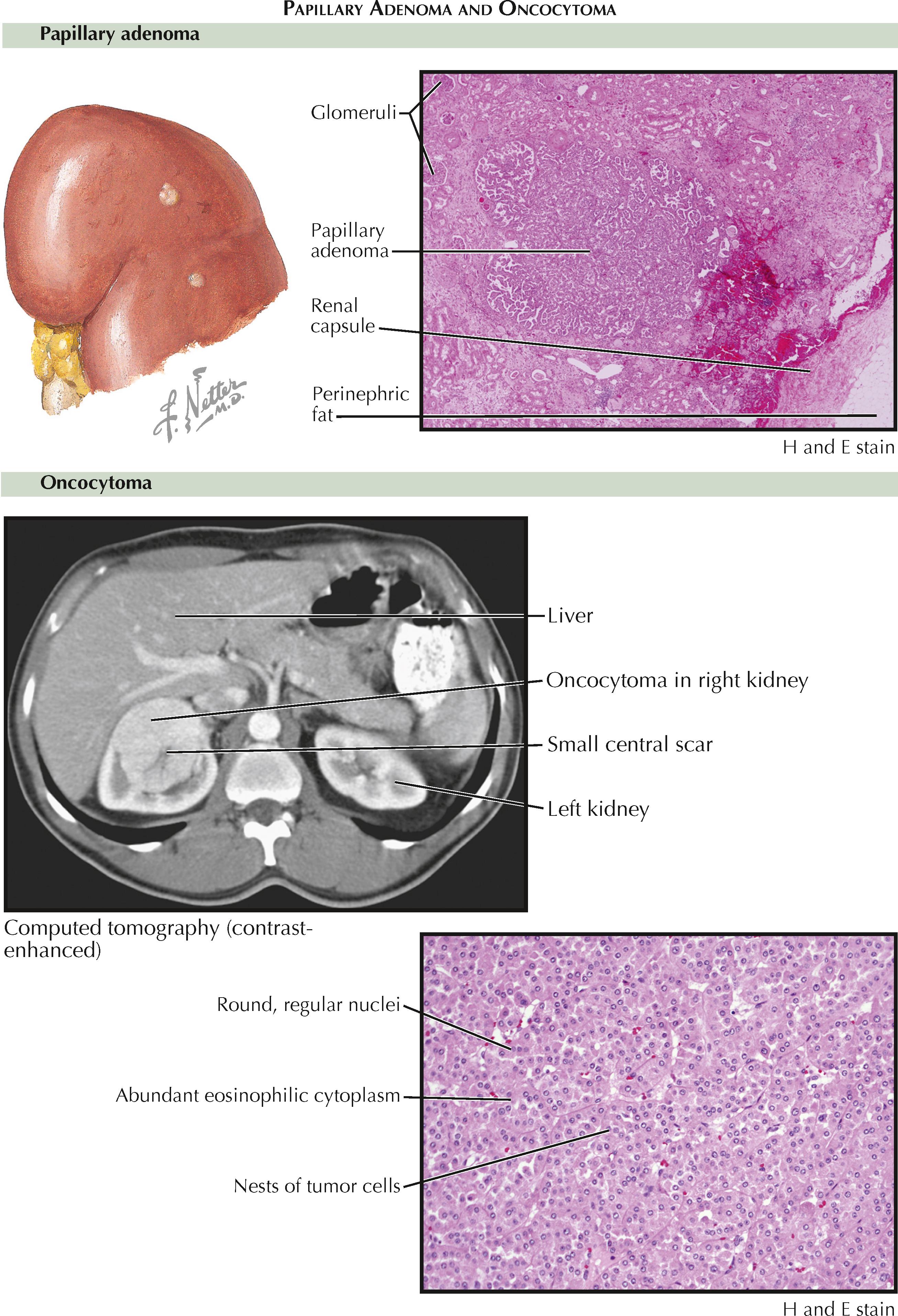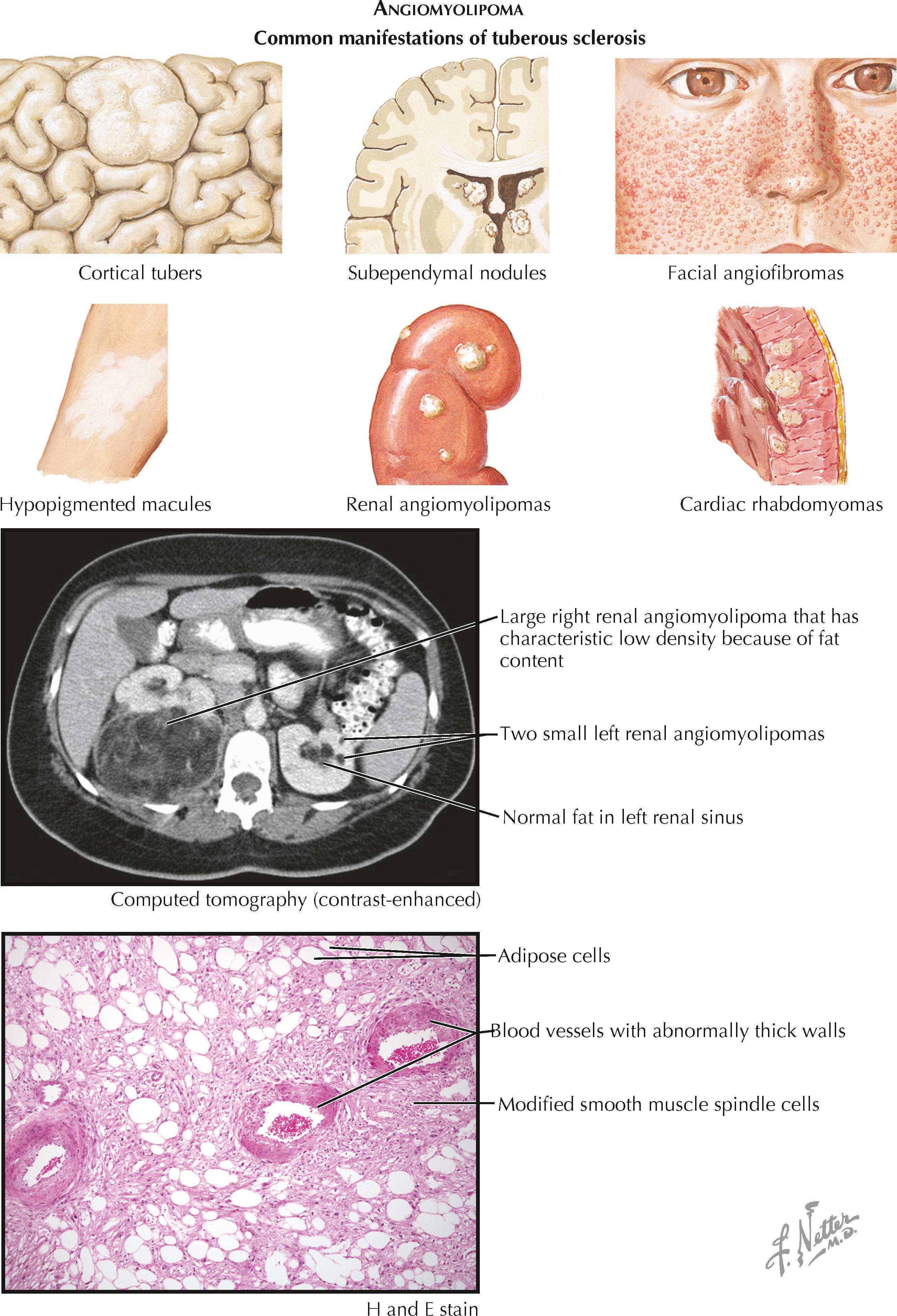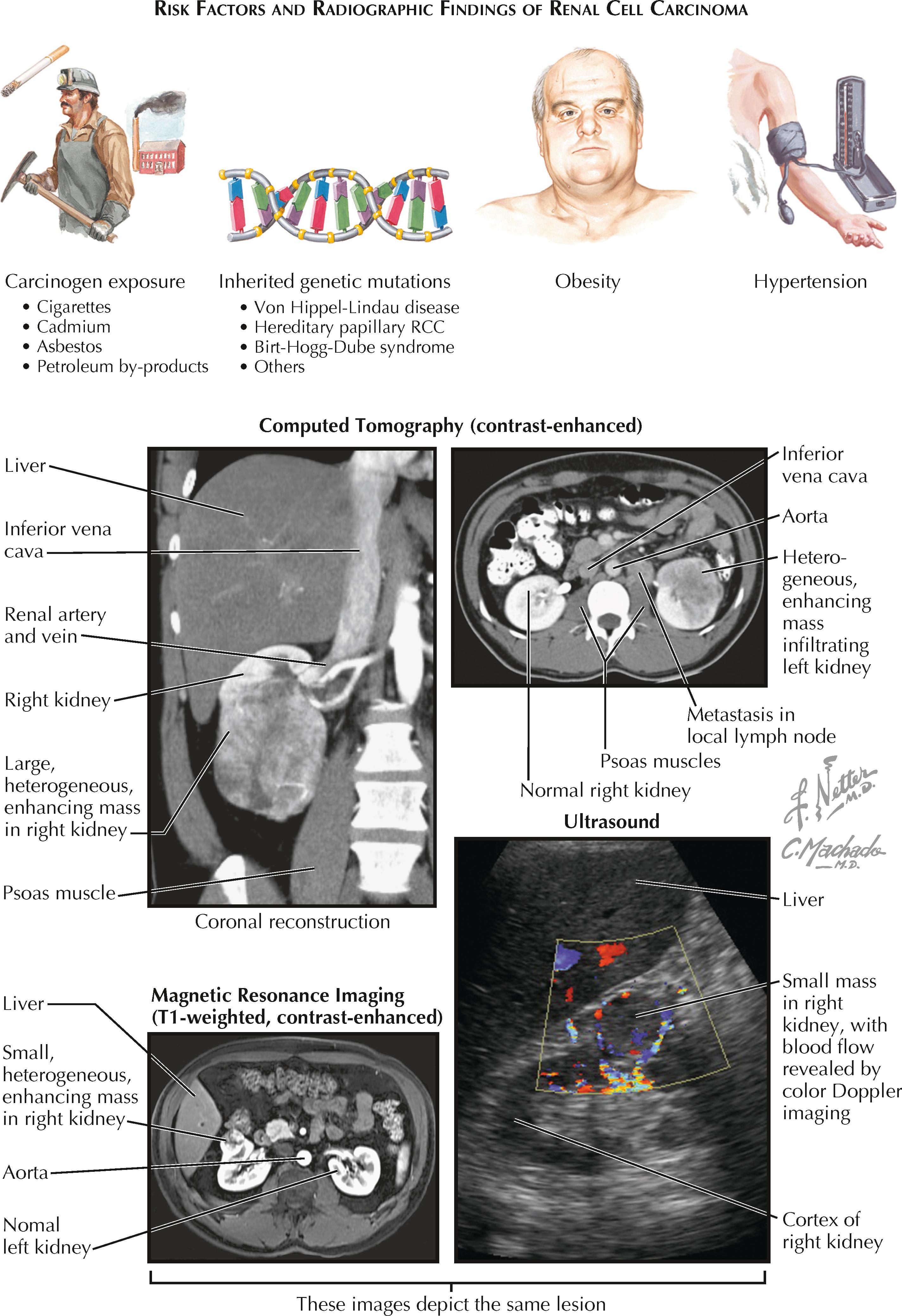Physical Address
304 North Cardinal St.
Dorchester Center, MA 02124
There are several different kinds of benign renal tumors, which may originate from a wide range of cell types. Solid renal tumors, however, are generally malignant, with the probability of malignancy strongly correlating with tumor size. For example, one series found that masses greater than 4 cm in diameter were malignant in more than 90% of cases, whereas those less than 1 cm in diameter were malignant in 54% of cases. Although certain benign tumors have characteristic radiologic findings, most cannot be distinguished from malignant tumors using imaging alone. Thus most solid masses are surgically removed, with the final diagnosis rendered only after histopathologic examination. Some of the more common and well-documented benign renal tumors are presented here.
Small cortical lesions are seen in 7% to 23% of kidneys at the time of autopsy. These are defined as papillary adenomas by the World Health Organization Classification of Tumours when they possess papillary or tubular architecture of low nuclear grade and are 5 mm or smaller in diameter. These masses are too small to be reliably detected using modern imaging techniques.
Oncocytomas account for approxmately 5% of renal tumors in adults. They are often incidental findings, occurring most commonly in those over the age of 50. They are believed to originate from the intercalated cells of the collecting duct. Classic radiographic features include a central stellate scar on CT imaging and a spoke-wheel pattern of blood vessels on angiography; however, these findings are unreliable and frequently absent, and angiography is now rarely performed as part of the diagnostic workup. Thus oncocytomas cannot reliably be distinguished from malignant tumors using noninvasive methods. Biopsies, however, are also unreliable because oncocytoma-like areas can be found in chromophobe renal cell carcinomas. Thus even a suspected oncocytoma is generally treated like a renal cell carcinoma, with the definitive diagnosis established only after surgical resection of the entire mass. Grossly, the tumors appear well-circumscribed and mahogany brown, with a central stellate scar seen in about one third of cases. There may be small areas of hemorrhage, but necrosis should not be seen. Characteristic histopathologic findings include round to polygonal cells that have strongly eosinophilic cytoplasm and round nuclei, and which are arranged in nests, acini, tubules, and microcysts.
Angiomyolipoma (AML) of classic type are benign mesenchymal neoplasms composed of blood vessels, smooth muscle, and adipose tissue. (There are rare AMLs of epithelioid type that can exhibit malignant behavior.) About half of AMLs occur in otherwise healthy individuals, generally in their fifth or sixth decade. Most of the remainder occur in those with the genetic disorder known as tuberous sclerosis (TS), which has numerous manifestations affecting multiple organ systems. Besides renal AML, the other major clinical features of TS include cerebral cortical tubers; subependymal nodules; retinal hamartomas; cardiac rhabdomyomas; facial angiofibromas, typically in a malar distribution (formerly known as adenoma sebaceum); hypopigmented macules known as ash-leaf spots; orange peel-like plaques on the lower back known as shagreen patches; and periungual fibromas (flesh colored papules near the fingernail bed). 70% to 80% of patients with tuberous sclerosis develop renal AMLs, typically in their fourth decade. Benign renal cysts may also be seen.

Like other renal tumors, AMLs are often discovered as incidental findings on axial imaging. Less commonly, the tumors may cause flank pain, hematuria, and a palpable abdominal mass. In rare cases, life-threatening retroperitoneal hemorrhage may occur, a phenomenon known as Wunderlich syndrome. AMLs can often be distinguished from other renal masses using computed tomography (CT) because their fat content causes them to appear as hypoattenuating lesions (less than −20 Hounsfield units). The presence of fat, however, is not pathognomonic for AML, since certain primary renal sarcomas (such as liposarcoma) and rare renal cell carcinomas may also contain fat. In addition, AMLs sometimes have little fat content that cannot be visualized with CT imaging.
The optimal management of an AML depends on tumor size and associated symptoms. Lesions that are more than 4 cm in diameter or that cause pain or hematuria are managed with embolization or extirpation (with a nephron-sparing technique whenever possible). Fat-poor tumors that cannot be confidently distinguished from renal cell carcinoma should also be removed. In contrast, patients with smaller, asymptomatic lesions that strongly resemble AML can be monitored with serial imaging studies at 6- to 12-month intervals.
Grossly, an AML is typically solid and well circumscribed, although it is not encapsulated. Patients with sporadic AML tend to have a single, large mass, whereas those with TS tend to have multiple, small masses. Microscopically, the mature adipose tissue varies in amount: in some cases it constitutes most of the tumor, whereas in others only rare adipocytes are present. The blood vessels have abnormally thick walls. The smooth muscle cells may be spindled and grow in bundles or epithelioid with abundant eosinophilic cytoplasm. Immunohistochemical stains are often valuable, especially in small needle biopsy samples. The smooth muscle cells express both smooth muscle markers (smooth muscle actin and h-caldesmon) and melanocytic markers (such as HMB-45 and Melan-A), and they are negative for epithelial markers (cytokeratin).
Cystic nephromas, sometimes called multilocular cystic nephromas, are benign tumors most often discovered in women in their fourth or fifth decade. They should be distinguished from cystic nephromas in children, which are considered to be differentiated Wilms tumors. On axial imaging, cystic nephromas are well-circumscribed and contain multiple noncommunicating, fluid-filled cystic spaces and no calcifications. Thus, they resemble category III or IV cysts according to the Bosniak classification scheme (see Plate 2-14 ), raising concern for renal cell carcinoma. As a result, they are usually surgically resected with either a radical or partial nephrectomy, depending on size and location. On histopathologic examination, the septa consist of fibrous tissue lined by cuboidal cells that may show hobnail features and flattening.
Metanephric adenomas are rare benign tumors that are often incidental findings in middle aged individuals, with a higher incidence among women than among men. Like other renal tumors, they occasionally cause hematuria, abdominal or flank pain, and a palpable abdominal mass. They may also cause secondary polycythemia. They resemble renal cell carcinomas on axial imaging, and it is often difficult to distinguish between the two. Thus these masses are usually surgically resected, with the definitive diagnosis established on histopathologic analysis. Grossly, most metanephric adenomas are 3 cm to 6 cm in diameter, and they are usually solid with gray to tan to yellow cut surfaces. The histopathologic findings include closely packed small, uniform round acini composed of small bland nuclei. Psammoma bodies may be seen.
In addition to AML, several other benign mesenchymal renal neoplasms have been reported in the kidney, including juxtaglomerular cell tumor, leiomyoma, hemangioma, lymphangioma, schwannoma, lipoma, solitary fibrous tumor, myxoma, and neurofibroma.

Juxtaglomerular tumors are rare, benign, renin-secreting masses derived from the juxtaglomerular apparatus. The classic presentation is a young patient (<25 years) with headache and hypertension who is found to have elevated serum renin and aldosterone concentrations and a low serum potassium concentration. Most tumors are unilateral, solitary, and relatively small (2 to 3 cm). Treatment consists of surgical removal, preferably with nephron-sparing surgery. Grossly, these tumors are well-encapsulated, with tan to yellow solid cut surfaces. Microscopically, the appearance is quite variable, with many tumors showing sheets of uniform round cells.
Renal hemangiomas are rare benign lesions that may cause either microscopic or gross hematuria. Most lesions are small and cannot be visualized using routine axial imaging of the kid-ney. Historically, arteriography was the most sensitive imaging modality; however, most renal hemangiomas are now diagnosed using cystoscopy, in which patients are noted to have unilateral hematuria (i.e., gross blood emerging from only one ureteric orifice). Most hemangiomas are located at the tip of a papilla and can range in size from pinpoint to several centimeters in diameter. In the past these masses were treated with nephrectomy or embolization; at present, however, treatment is usually electrocautery or laser ureteroscopic ablation.
Renal cell carcinomas (RCC) account for a vast majority of primary malignant renal tumors. Approximately 55,000 new cases are diagnosed in the United States each year, and about one third of patients have metastatic disease. Other, less common malignant renal tumors include transitional cell carcinomas of the renal pelvis (see Plate 9-9 ) and primary renal sarcomas. The kidneys may also contain metastases from extrarenal solid and hematologic tumors.
RCC was once more than twice as common among men than among women, although this gap currently appears to be shrinking. The peak incidence is in the sixth to seventh decades of life. Environmental risk factors include cigarette smoking and exposure to cadmium, asbestos, or petroleum byproducts. Data suggest that cigarette smoking and cadmium exposure each double the risk, and that smoking alone is responsible for one third of total cases. In addition, genetic abnormalities in critical tumor suppressor genes and oncogenes are known to play a key role. Such mutations can be sporadic or part of a hereditary condition, such as von Hippel-Lindau disease, hereditary papillary RCC, and Birt-Hogg-Dube syndrome. Hypertension and obesity also increase the risk for RCC, although the mechanisms are not known. Although many tumors occur in patients without known risk factors, it is likely that a significant number of “sporadic” cases will eventually be found to have a genetic basis.
In the past, an RCC was typically not detected until it became symptomatic, usually as the classic triad of gross hematuria, flank pain, and a palpable mass. In contemporary practice, however, the classic triad is seen in fewer than 10% of patients. Instead, the majority of renal masses are now incidentally detected during abdominal imaging.
Nonetheless, an RCC may also cause a variety of nonspecific symptoms, including weight loss, fever, night sweats, and lymphadenopathy. Some patients may also have dyspnea, cough, and bone pain, which are suggestive of metastatic disease. Finally, RCC can also be associated with a wide variety of paraneoplastic phenomena, including erythrocytosis, anemia, hypercalcemia, hypertension, and nonmetastatic hepatic dysfunction (Stauffer syndrome). Patients with any combination of these symptoms or syndromes require immediate evaluation for possible RCC.
The evaluation of a known or suspected RCC begins with a thorough history and physical examination, with careful attention to the symptoms listed previously. On laboratory assessment, possible abnormalities include abnormal hematocrit, elevated erythrocyte sedimentation rate, elevated serum calcium concentration, and abnormal liver function tests. Finally, a careful evaluation of kidney function is important because it may have a significant impact on the type of management if RCC is diagnosed. A normal serum creatinine concentration is an acceptable assessment of renal function in patients with no comorbidities and normal-appearing kidneys on standard axial imaging. In patients with medical conditions that predispose to renal disease, such as hypertension and diabetes mellitus, assessing the function of each kidney with a nuclear scan may be helpful for deciding between radical and nephron-sparing approaches.

Several imaging techniques may be used to evaluate a suspected RCC, including ultrasound (US), computed tomography (CT), magnetic resonance imaging (MRI), renal angiography, and radionuclide imaging (renography).
CT scan is the most frequently employed modality because it has a high sensitivity for detecting renal masses and is the most accurate. Any renal mass that enhances with contrast is potentially malignant. CT also provides excellent visualization of the adjacent structures into which the primary tumor can extend or metastasize—such as the renal vein, regional lymph nodes, inferior vena cava, and suprarenal (adrenal) glands—which enables accurate staging.
Ultrasound can help identify the presence of a renal mass. Although ultrasound evaluation does not require ionizing radiation and is less expensive than CT, it is less sensitive and is highly dependent on operator skill.
MRI is as sensitive as CT and is the study of choice for patients who cannot receive iodinated contrast.
The most common sites for metastasis of renal cell carcinoma include the local and thoracic lymph nodes, lungs, liver, bone, brain, ipsilateral suprarenal gland, and contralateral kidney. Thus metastatic evaluation should include a chest radiograph/CT scan and liver function tests. Bone scans may be indicated if the patient complains of musculoskeletal pain, or if the serum calcium or alkaline phosphatase concentrations are elevated.
Renal tumors are generally not biopsied because of concerns regarding complications, the false-negative result rates, and the fact that an overwhelming majority (>90%) of renal masses greater than 4 cm in diameter are malignant. In contemporary practice, with more small renal tumors (<4 cm) being identified, the role of renal biopsy is actively being reevaluated, and it is likely that in the future renal biopsy will become a more common practice. Potential complications include bleeding, infection, needle track seeding, and pneumothorax. In addition, false negatives for malignancy do occur.
Become a Clinical Tree membership for Full access and enjoy Unlimited articles
If you are a member. Log in here